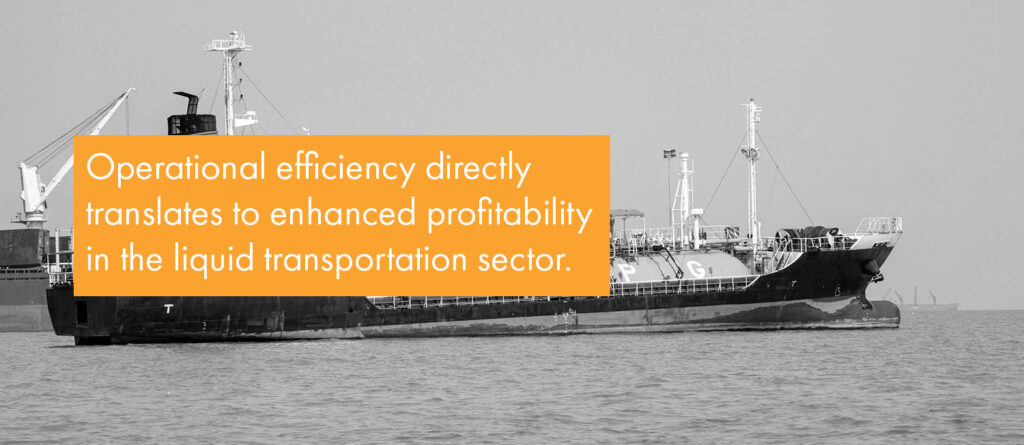There are no magic bullets when it comes to increasing efficiency in liquid transportation. Instead, small steps can have significant impacts when barge operators focus on the right pain points and apply effective tools and strategies to resolve them. Here are some key areas to consider when starting your efficiency improvement journey and some strategies for making meaningful improvements.
Understanding the Challenges of Liquid Transportation
Transporting liquids presents a unique set of challenges, distinguishing it significantly from transporting solid goods. Unlike solid cargo, liquids are inherently unstable and prone to movement within their containers, which can lead to a range of complications. These complexities can translate into increased costs and operational hurdles for barge transport business owners if not managed properly.
One of the primary challenges in liquid transportation is maintaining the integrity of the cargo. Many liquids, such as chemicals, petroleum products, and food-grade liquids, require specific temperature controls to prevent spoilage or chemical reactions. This need for temperature regulation necessitates sophisticated monitoring and control systems to ensure the cargo remains within the required parameters throughout the journey. Failure to maintain these conditions can lead to significant financial losses and, in some cases, severe safety hazards.
Another critical challenge is preventing contamination. Liquids are highly susceptible to contamination from various sources, including residues from previous shipments, environmental factors, and even the materials used in their storage containers. Ensuring that tanks and containers are thoroughly cleaned and sanitized before each new load is essential to maintaining the purity and quality of the cargo. This process can be time-consuming and costly, especially if inadequate tracking leads to duplicate or missed work.
Missing work can also have disastrous results. A barge company was fined $18,000 after poorly maintained barges corroded and spilled almost 40,000 pounds of liquid fertilizer into the Colombia and Snake Rivers. That figure doesn’t account for the cost due to losing cargo en route or the damage to the company’s reputation with its customers. Ensuring you’re on top of critical maintenance tasks can feel small, but is always important.

Improving Operational Efficiency in Liquid Transportation
Enhancing operational efficiency in liquid transportation hinges on several strategies, with detailed logging and reporting playing a pivotal role.
First, you need thorough, real-time information about your barges. Efficiency depends on being able to plan your deployments effectively. You never want to have to replace a barge on a trip because it wasn’t properly cleaned. Likewise, a barge that goes out of commission because of a missed maintenance event will hurt your bottom line—and, depending on the liquid being transported, could result in a dangerous situation for the crew and the environment. Detailed logging of all activities is critical for increasing operational efficiency, as you won’t be able to identify your specific bottlenecks and create improved processes without good information.
Second, you need logging that is as close to real-time as possible. Historically, much of our onboard deck logging was done by hand, which delays nearly every step of the process. Even if reports are being emailed, it still takes someone time to sit down and create the email, and the information often has to be interpreted and logged on the other side before it can be used. Whether that leads to minutes, hours, or days of delays, manual logging often results in missing key opportunities to fix problems, like a missed cleaning or maintenance event, while they’re still cheap and simple to fix. Digital logging enables barge operators to better understand their fleets’ true status and respond to potential issues before they become significant.
Enhancing Profitability in Liquid Transportation
Operational efficiency directly translates to enhanced profitability in the liquid transportation sector. Businesses can significantly lower operational costs in the marine transport of liquids by reducing waste and preventing costly incidents through real-time monitoring and proactive maintenance. But there’s more to profit than reducing cost—accurate, timely billing is necessary to avoid painful delays and receive the full amount your company is owed for your work.
But accurate billing matters just as much. Customers get confused by incomplete bills and hate receiving follow-up bills with missing line items for a previously paid service. Companies can provide precise and transparent billing information by meticulously recording every aspect of the transport process, from loading to delivery. This comprehensive data capture includes timestamps, quantities, handling conditions, and any deviations or incidents during transit. Such thorough documentation allows for quicker reconciliation of services rendered against contractual agreements, minimizing disputes and delays in payment.
Additionally, detailed logs help generate accurate invoices promptly, ensuring that customers are billed for the exact services received without any discrepancies. This “customer-friendly billing” builds trust with clients and accelerates the billing cycle, improving cash flow and financial stability for the business. If you better track and log your services, key billable items are less likely to fall through the cracks.
Get Started with BargeOps Liquids
A common theme we’ve touched on throughout is that the more you can streamline these processes with technology, the easier it is to improve efficiency. With BargeOps Liquids, barge operators can track, automate, and simplify almost every aspect of their billing process because higher-quality billing is good for the company and the customer. BargeOps Liquids takes onboard events, like fueling, fuel tax, lubrication, fleeting, inspections and more so that you can comprehensively view chargeable events for your entire fleet in real-time. You can set charges for these events globally or on a per-customer basis or even alter them for a single trip so that your billing easily adapts to the reality of your contracts.
Generating a bill shouldn’t be time-consuming, and BargeOps Liquids makes it easy. You can create bills on-demand whenever you need to, so whether you’re charging by leg or for the entire trip, you can create an accurate, complete bill for any of your customers in seconds. You can then track how you sent the bill, and its status. With its complete line-item information automatically included for you, you can have peace of mind that customers will have fewer disputes and will be more likely to pay on time. To get started with BargeOps Liquids, schedule a free demo today to learn more about what it can do for your barge operation.


